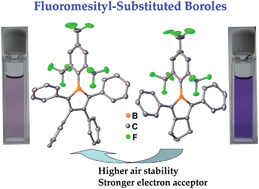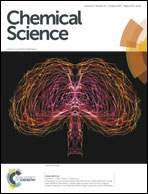Taming the beast: fluoromesityl groups induce a dramatic stability enhancement in boroles†
Abstract
The electron-deficient pentaarylborole 1-(2′,4′,6′-tris(trifluoromethyl)phenyl)-2,3,4,5-tetraphenylborole (1) has been synthesised with the long-term aim of developing borole-based optoelectronic materials. The bulky 2,4,6-tris(trifluoromethyl)phenyl (FMes) group on the boron atom of 1 significantly improves (>600 times) its air stability relative to its mesityl analogue. Moreover, 1 shows good thermal stability without undergoing the dimerisation or isomerisation reactions reported for some other boroles. A triarylborole analogue (2), belonging to a new class of borole with the 3- and 4-positions of the BC4 ring linked by a –(CH2)3– group, has also been synthesised to elucidate the influence of carbon-bonded substituents on the stability of boroles. Both boroles were prepared through the reaction of Li[FMesBF3] and divinyldilithium reagents, a new and general method for borole syntheses. Compound 2 was found to isomerise through a [1,3]-H shift and double-bond rearrangement to an s-trans-butadienylborane species under highly basic (NaOH) conditions. The increased steric crowding at the boron centre through incorporation of the FMes group does not preclude binding of Lewis bases to either 1 or 2, as demonstrated by their fully reversible binding of pyridine. Interestingly, 1 exhibits a blue-shifted absorption spectrum, as compared with its mesityl analogue, a result contrary to previous understanding of the influence of substituent electronics on the absorption spectra of boroles. Most importantly, these boroles exhibit much greater air-stability than previously reported analogues without sacrificing the strong electron-accepting ability that makes boroles so attractive; indeed, 1 and 2 have very low reduction potentials of −1.52 and −1.69 eV vs. Fc/Fc+, respectively.


 Please wait while we load your content...
Please wait while we load your content...